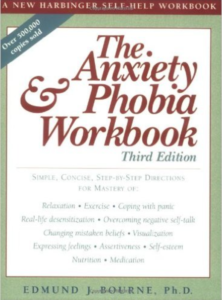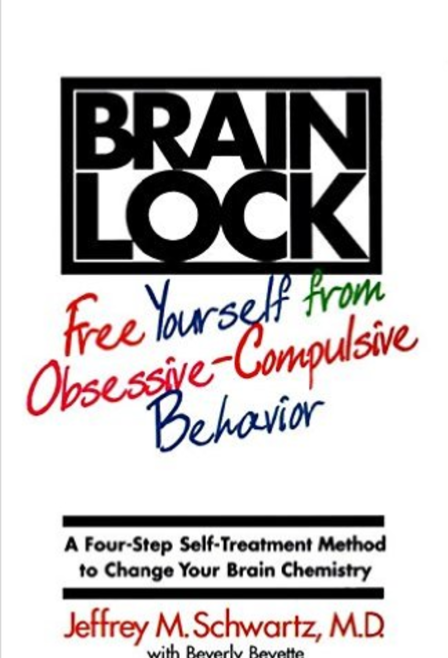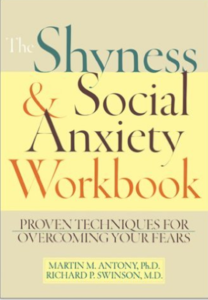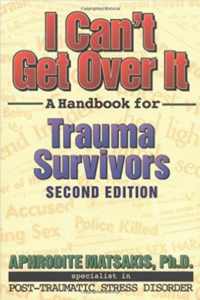Discover why you feel what you do so that you may achieve the sense of serenity you need and deserve.
Take Control of Your Anxiety
It's your turn to take charge.
If you suffer from some form of anxiety, you’re not alone. Anxiety effects 18% of the U.S. adult population. It manifests itself in various forms and is often associated with depression, low self-esteem, numerous physical symptoms and disorders, substance abuse disorders, ADD/ADHD and more.. Below is helpful information about the different types of anxiety disorders that exist. In order to help you get started, I’ve created a self-test that should give you greater insight on what you’re feeling. Once you’ve reviewed that information, you may also be interested in reading the material I’ve provided about Cognitive Behavioral Therapy (CBT) and The “1-2-3” Method of Brain Retraining and Insight Therapy. I use a combination of these successful methods and therapies in order to treat my clients.
BEGIN YOUR JOURNEY BY TAKING THE SELF-TEST
Anxiety Disorders
Panic Disorder is a disorder that manifests recurrent unexpected panic attacks with persistent concerns about having more attacks. There is also significant fear as to the implications and consequences of the attacks, such as the fear of a medical or mental crisis. These fears may cause a significant change in behavior related to the attacks.
A Panic Attack involves a sudden onset of fear that reaches a peak within 10 minutes, and involves four or more of the following:
- palpitations, pounding heart or accelerated heart rate
- sweating
- trembling or sweating
- sensations of shortness of breath or smothering
- feeling of choking
- chest pain or discomfort
- nausea or abdominal distress
- feeling dizzy, unsteady, lightheaded or faint
- derealization (feelings of unreality) or depersonalization (being detached from oneself)
- fear of losing control or going crazy
- fear of dying
- paresthesias (numbness or tingling sensations)
- chills or hot flushes
Panic attacks may occur with or without Agoraphobia which is defined as:
Anxiety about being in places or situations from which escape may be difficult or embarrassing, or in which help may not be readily available in the event of having a panic attack. These fears often include:
- being outside of ones home alone
- being in a crowd
- standing in a line
- being on a bridge or in a tunnel
- travel in a car, bus, train or airplane
These fearful situations are avoided or are endured with significant anxiety of having a panic attack or a related mental or medical crisis.
(adapted from: Diagnostic and Statistical Manual of Mental Disorders IV, American Psychiatric Association, 1994).
Treatment of Panic Disorder
There are several different approaches taken in treating PD. These include:
- Psychopharmacology (medication)
- Psychoanalytic
- Psychodynamic
- Hypnosis
- Relaxation Techniques
- Insight
- Cognitive – Behavioral Therapy (CBT)
Some therapists will attempt to use psychoanalytic or psychodynamic therapy in an attempt to understand the underlying issues that may be symbolically manifesting in panic attacks. These approaches however are often lengthy, and therefore expensive, and may be of limited benefit. Hypnosis and relaxation approaches are of very limited value when used alone, but may increase the effectiveness of other approaches when used as an additional tool. And insight oriented therapy can be effective but usually if it is used in addition to the most effective treatment method: Cognitive-Behavioral Therapy or CBT. Many research studies have demonstrated the effectiveness of CBT when used alone or in conjunction with medication or insight therapy.
I have found that the most effective form of treatment for PD is: CBT used along with insight therapy, and sometimes with medication.
In addition to CBT and insight therapy, I also have patients complete a “timeline”: a chronological review of important life events. This provides me with important information regarding events that may have contributed to the development of anxiety symptoms, and provides greater insight for the person completing such a journal. I also always advise “Bibliotherapy”: or recommended reading of the issue, topic or problem being addressed in therapy. I almost always recommend to new patients that they read a book on anxiety disorders and their treatment, usually recommending “Anxiety and Phobia Workbook.” This is the single best book I have thus far found for providing an overview of all anxiety disorders. I have sent many patients to local bookstores in search of it, but it can be obtained through this link to Amazon.com at a significantly reduced price compared to purchasing in a store. Also, go to the RECOMMENDED READING page on this site for more advised reading including valuable articles included on this site.
The Anxiety & Phobia Workbook
Edmund J. Bourne
Obsessive-Compulsive Disorder (OCD) is a disorder that manifests either obsessions or compulsions.
Obsessions are defined as:
- recurrent and persistent thoughts, images or impulses that are inappropriate and intrusive, causing considerable anxiety and distress
- these thoughts are not realistic
- attempts are made to ignore or suppress these thoughts
Compulsions are defined as:
- repetitive behaviors or mental acts that result from obsessive thoughts
- these behaviors or mental acts attempt to prevent some dreaded event or situation
- these behaviors or mental acts are not connected in a realistic way to avoid these dreaded events
Adapted from: Diagnostic and Statistical Manual of Mental Disorders IV, American Psychiatric Association, 1994.
MANAGEMENT OF OCD
I teach individuals with OCD the following four techniques to help them reduce the frequency and intensity of their obsessive thoughts and compulsive behaviors.
RELABEL
Relabeling helps you recognize that an obsessive thought is a false alarm caused by biological imbalances in the brain.
- Call it what it is: learn to recognize and properly label obsessive thoughts and compulsive urges.
- Say to yourself: “This thought is an obsession; this urge is a compulsive urge.”
- The goal is to control your responses to the thoughts and urges, not to control the thoughts and urges themselves.
REATTRIBUTE
- The most important thing is to realize: “It’s not me – it’s my OCD.”
- OCD should be called: “Out of Control of me Disorder”.
- OCD is caused by a biochemical imbalance in the brain. The brain tends to get “stuck in gear” – it has difficulty shifting out of one thought or action into the next.
REFOCUS
- You must shift your brains gears yourself by forcing yourself to engage in some other behavior to replace compulsive washing, checking or compulsive preoccupations.
- Say to yourself: “I’m experiencing a symptom of OCD. I need to do another behavior.”
- Choose any constructive, pleasant behavior – such as a hobby or enjoyable activity. Go for a walk, exercise, listen to music, read, play a computer game, knit or shoot a basketball.
- The Fifteen Minute Rule: delay your response to an obsessive thought or an urge to perform a compulsive behavior by letting at least 15 minutes elapse before doing so. Never perform the compulsion without some time delay. The longer you wait, the more the urge will decrease.
- Most importantly – don’t do what your OCD is telling you to do!
- Keep a journal of your successes in refocusing.
REVALUE
- Do not take OCD at face value. The obsessions are not constructive, they are not worth listening to. And the compulsions are not helpful and they are a waste of time.
- You can’t make the thought go away, but you don’t need to dwell on it or act on it.
One of the best books on OCD, especially strategies and techniques to reduce obsessive thought and compulsive behavior, is “Brain Lock” by Jeffrey Schwartz, M.D. His four-step method that is summarized above helps the person with OCD learn to mentally shift gears to reduce obsessions, and offers techniques to develop behaviors that increase control over compulsions. The following is a link to purchase the book from Amazon.com at a price much lower than retail in a bookstore.
Social Phobia is a disorder that manifests marked and persistent fear of one or more social or performance situations in which one is exposed to unfamiliar people or the scrutiny of others.
In addition:
- the individual fears they may behave in such a way that will be embarrassing or humiliating, or that their anxiety symptoms may be obvious to others
- exposure to the feared social situation almost always provokes anxiety, which may even lead to a panic attack
- in children, the anxiety may be expressed as crying, tantrums, freezing or shrinking from social situations with unfamiliar people
- individuals with Social Phobia recognize that their fear is excessive and unrealistic
- feared social situations are either endured with intense anxiety, or are avoided altogether
- the anxiety or avoidance of social situations interferes with the individual’s normal routine, either:
- occupational or academic functioning
- social functioning
- personal relationships
(adapted from: Diagnostic and Statistical Manual of Mental Disorders IV, American Psychiatric Association, 1994).
As with Panic Disorder, the most effective form of treatment for Social Phobia is Cognitive Behavioral Therapy (CBT). The CBT focuses on identifying anxiety provoking thoughts, beliefs and self-talk. Once these thoughts, or cognitions, are identified the next step is one of challenging their validity and accuracy. The final step is to modify those ideas to make them more realistic and therefore more positive.
An example: An individual has the belief that when he goes into a store, he may pass out and be humiliated. The bigger the store, or the farther he goes into the store, the further away he is from the exit. That triggers a “fight or flight” response. He doesn’t have anyone or anything to fight, therefore his reaction is to take flight – therefore the need for quick access to an exit. Joe believes that if he cannot escape quickly enough, he may start to hyperventilate and pass out. The more he fears this happening, the more likely it is to happen. The purpose of CBT then is to identify the false belief that he may pass out if he becomes anxious or hyperventilates. Reviewing his history indicates that many times he has become similarly anxious but has not passed out. The false belief that passing out is possible is identified and challenged. The false belief that passing out is a disaster or a catastrophe is also identified and challenged. New thoughts and beliefs are established that end the start of the fear of fear cycle.
Sometimes individuals with Social Phobia may also benefit from insight oriented psychotherapy in addition to CBT. This is the case when childhood influences or events have helped contribute to the development and maintenance of the cognitions that contribute to social anxiety.
As with all patients I see with an anxiety or other mood disorder, I recommend “Bibliotherapy” i.e. reading material. This helps speed up the therapy process by helping the patient learn more about their anxiety between sessions. One of the best books on Social Phobia that I recommend is “The Shyness and Social Anxiety Workbook”. It is available through the following Amazon.com link at a price significantly reduced from the store price.
The Shyness & Social Anxiety Workbook
Martin M. Antony
Post-traumatic Stress Disorder (PTSD) is a disorder that can develop in an individual who was exposed to a traumatic event in which the following occurred:
- the person experienced or witnessed an event that involved actual or threatened death or serious injury to oneself or to another
- the person experienced intense fear or helplessness in response to the event
The traumatic event is frequently re-experienced in one or more of the following ways:
- recurrent and distressing thoughts, perceptions or images of the event
- recurring dreams of the event
- acting or feeling as if the traumatic event was recurring or a sense of reliving the experience
- intense fear upon experiencing internal or external reminders of the event
- physical reactions upon experiencing internal or external reminders of the event
Persistent avoidance of things associated with the traumatic event, along with numbing of responses such as:
- efforts to avoid thoughts, feelings or conversation about the event
- efforts to avoid people, places or events associated with the event
- difficulty being able to recall aspects of the event
- decreased interest or participation in significant activities
- feelings of detachment or estrangement from others
- restricted range of emotions, such as a difficulty experiencing loving feelings
- a sense of having a foreshortened future, such as having a short life span, not having a career, marriage or children
Persistent symptoms of increased arousal, such as:
- difficulty falling or staying asleep
- irritability or short temper
- concentration difficulty
- hypervigilence
- exaggerated startle response
Adapted from: Diagnostic and Statistical Manual of Mental Disorders IV, American Psychiatric Association, 1994.
One of the best books on PTSD is “I Can’t Get Over It”. I have recommended this book to several patients for its clear and effective recommendations for reducing the symptoms of PTSD. The following is a link to purchase this book from Amazon.com at a price that is significantly less than retail.
I Can’t Get over It
Aphrodite Matsakis
Generalized Anxiety Disorder (GAD) is a disorder that manifests excessive anxiety and worry that occurs more days than not for six months or longer, about a number of concerns such as family, work or school. The individual experiencing GAD finds it difficult to control their worry.
In addition, the individual experiences three or more of the following symptoms:
- restlessness or feeling keyed up or on edge
- easily fatigued
- difficulty concentrating or mind going blank
- irritability
- muscle tension
- sleep disturbance (difficulty falling or staying asleep, or restless unsatisfying sleep)
The anxiety, worry or physical symptoms cause significant distress or impairment in social, occupation or other important areas of ones life.
Adapted from: Diagnostic and Statistical Manual of Mental Disorders IV, American Psychiatric Association, 1994.
The Dynamics of Anxiety Disorders
This theory was published in 1992 by Arthur Barsky, M.D., an associate professor of psychiatry at Harvard Medical School.
The term Somatosensory Amplification or more simply amplification, refers to the tendency for physical sensations to be experienced as disturbing because they seem to be intense and unpleasant. The term also refers to the tendency to especially focus on uncomfortable bodily sensations and consider them to be abnormal rather than normal. Amplification significantly contributes to somatization (or preoccupation with physical sensations) that characterizes hypocondriasis and other psychosomatic disorders, especially panic attacks and Panic Disorder. Amplification also occurs to one extent or another in all anxiety disorders
There are three elements involved in the amplification process:
- Hypervigilence: A tendency to be over focused on bodily sensations and pay excessive attention to all sensations, especially those that are unpleasant.
- Selective Focus: A tendency to to select out and focus on infrequent, weak or unusual bodily sensations.
- Mislabeling: A tendency to consider physical sensations as abnormal and symptomatic of disease, rather than as normal and benign. These three elements often lead to a sense of danger and threat from bodily sensations.
There is a natural variability among people in their sensitivity to bodily sensations, especially in their threshold and tolerance for physical discomfort and pain. Individuals who are more sensitive to pain can be considered amplifiers, while those who are less sensitive to pain can be considered minimizers. Amplification may be learned in childhood and/or may be a biological predisposition present from birth. The degree of amplification varies over time, so someone may amplify a sensation at one time or state of mind, and may not amplify it at another time or state of mind. There are four factors that influence the intensity of a sensation at any given time: cognition, context, attention, and mood.
COGNITION
Cognition refers to thoughts or the thinking process, so ones thoughts can significantly influence a sensation. We tend to experience a bodily sensation based upon our information, ideas or beliefs about that sensation. An example would be the experience of a headache. If one believes the headache is the result of stress or eye strain, there will likely be little anxiety over the headache and the headache will not seem terribly intense. However, if one believes the headache is the result of a possible brain tumor, the headache will likely feel much more intense. Ones thoughts about the sensation will influence the intensity of the sensation. This commonly occurs during the process of a panic attack, and therefore contributes to the creation of the panic attack.
CONTEXT
The circumstances or situation in which we experience a sensation will influence the intensity of the sensation. If many people around us have become ill with a cold or flu, we will be more inclined to believe that if we sneeze it may be a symptom of us also catching a cold or flu. At other times, we may not have paid much attention to that sneeze, believing it to be just a random sneeze. The context can also influence our perceptions. For example, waiting for someone who is late will cause us to be more sensitive to the approach of someone who resembles the person we are waiting for than we normally would be.
ATTENTION
Paying attention to any sensation automatically amplifies or intensifies it. At the same time, distraction will diminish the sensation. Thus ill people can tend to feel more ill when frequently asked about their symptoms or condition as it causes them to focus more on their symptoms. It is commonly known that behaviors such as yawning are called “contagious” because observing another yawn tends to make us yawn. The reason is attention. Seeing another yawn brings our attention to our own need to yawn, which literally oxygenates our cells and feels relaxing as well as reviving. Other behaviors that have an infectious quality are coughing and itching. Hearing someone else cough brings our attention to our own throat where we soon notice a slight sensation of dryness or scratchiness that we had previously been unaware of, and we then cough. Or observing someone scratch an itch brings our attention to our own sensations of dryness or itchiness, and we too may soon be scratching.
MOOD
A mood such as anxiety tends to make us think with a more negative bias than does a positive, relaxed mood. This can especially influence ones thoughts about their health, safety and well-being. Anxiety causes sensations to be appraised as more ominous and dangerous, therefore anxious people are inclined to catastrophize bodily sensations, and tend to interpret vague or ambiguous symptoms as abnormal rather than normal. (See companion theory: “Catastrophic Misinterpretation”). Anxiety causes self-consciousness that leads to increased self-scrutiny which amplifies preexisting sensations, and brings into focus sensations that previously were unnoticed. Studies have demonstrated that anxiety lowers the tolerance of, and threshold for, unpleasant or painful sensations.
These dynamics also apply equally to depressed moods. People who are depressed also have a negative and pessimistic bias to their thinking, which causes them to focus more on negative events and memories, including negative physical sensations. One result is a tendency to believe in negative outcomes – that things are not going to get better and may likely only get worse. Depressed people tend to think of themselves as defective or abnormal and tend to think about misfortune, illness or death. Depression causes people to focus their attention inward, increasing preoccupation with physical sensations and amplifying mild and trivial discomfort, resulting in alarm.
This cognitive approach to explaining panic is credited to David M. Clark, M.D., a British psychiatrist who published his theory in 1985.
Certain drugs such as excessive caffeine; or certain behaviors such as voluntary hyperventilation; can trigger panic attacks. Though these drugs or experiences produce the same physical sensations in all people, usually only individuals with a history of panic attacks will experience a panic attack in response. Research has suggested the reason for this difference lies in the interpretation of the sensations. These drugs and physical sensations do not actually create panic, but the way in which the individual interprets the experience makes the difference between a response of panic or non-panic.
People who panic in response to certain stimuli do so as the result of a catastrophic misinterpretation of certain bodily sensations. The physical sensations usually misinterpreted are those involved in normal anxiety responses: dizziness, breathlessness or heart palpitations. These sensations are interpreted to be much more dangerous than they really are. One example is the healthy person who interprets heart palpitations as evidence of the start of a heart attack. Or a person interpreting a feeling of breathlessness as evidence they are suffocating and will therefore die. Or a person interpreting a shaky feeling as the start of the loss of control of themself and the onset of going crazy.
Both external and internal stimuli can provoke physical sensations. External tend to be places or situations where the person has previously experienced anxiety: a supermarket, a freeway, a bridge, or a certain social situation. Internal stimuli are bodily sensations, thoughts and/or images. If these stimuli are perceived as a threat, some mild anxiety is created. This mild anxiety creates, or intensifies, a wide range of physical sensations. If these sensations are then interpreted in a catastrophic manner, the fear increases. This then increases the body sensations and so on, creating a vicious cycle of sensations causing fear which cause sensations which cause fear. This has also been referred to as the fear of fear cycle.
This model applies to all panic attacks whether they are attacks that were preceded by anxiety, or the type of attacks that come “out of the blue”. In the first type, the anxiety that precedes the panic is called anticipatory anxiety, and that anxiety helped to actually create the panic attack. That is, the anxiety over a panic caused mental and physical sensations that caused catastrophic thinking, therefore leading to a panic attack. Again illustrating the fear of fear cycle: the fear of having a panic attack causes a panic attack.
Another situation involves anxiety that is not the result of a fear of panic, but rather anxiety over stressful events. During that period of anxiety, the person notices bodily reactions, and catastrophically interprets those sensations, and then panics. A third situation involves panics that are triggered not by anxiety or the fear of a panic, but rather by the misinterpretation of sensations that result from other emotions such as anger or excitement, or the misinterpretation of sensations caused by physical activity. Such harmless acts such as suddenly standing from a sitting position can cause dizziness; exercise can cause breathlessness or palpitations; or drinking caffeine can cause palpitations. When these sensations are noticed, they can be interpreted in a catastrophic manner, thereby triggering a panic attack. Often these attacks occur without the person consciously recognizing the triggering physical sensation and catastrophic misinterpretation, therefore these panics can appear to come “out of the blue”. In summary, the following are the elements involved in the:
Vicious Cycle of Panic
- Trigger Stimulus (internal or external) leads to:
- Perceived Threat leads to:
- Apprehension leads to:
- Body Sensations leads to:
- Interpretation of Sensations as Catastrophic which leads back to:
- Trigger Stimulus



